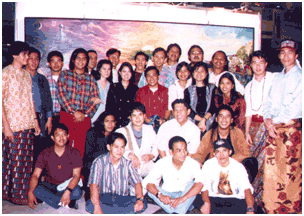

trompe l'eoil
(trump-loy)
Literally translates from French to mean "fools the eye." Hard to paint, the
trompe l'oeil piece requires meticulous attention to detail on the part of the
artist. Proper sizing and every detail, nuance of light and gradation of color
must be skillfully incorporated in order to make the two-dimensional work
appear to be three-dimensional.
Paintings of this genre have been around since Antiquity, though they fell
into disuse during the "Dark Ages" It wasn't until the Italians (re)discovered
linear perspective during the Renaissance that trompe l'oeil became popular
for keeps. In the 21st-century, the term "Photo-Realism" would be equally
applicable to this type of painting.
Source: arthistory.about.com
frottage
(fraw-tahzh)
The technique of rubbing with crayon or graphite on a piece of paper which has been placed over an object,
or an image achieved in this way. Also simply referred to as rubbing. Such impressions are usually made
from such highly textured subjects as leaves, wood, wire screen, gravestones, and manhole covers.
It was a technique especially employed by surrealists, one of whom, Max Ernst (German, 1891-1976), first
introduced frottage in his works in 1925, often employing such rubbings as part of a collage, or combining
frottage with painting techniques.
Source: artlex.com
faux
(foh)
From the French, faux literally means "false" or "artificial". In other words,
you're not looking the genuine article. To be blunt, faux(-anything) in art
is fake(-anything).
One can use the adjective "faux" in front of just about any man-made material
created to simulate something organic. Lots of decorative objects utilize
faux materials. Faux bois looks like wood, faux porphyry looks like stone,
faux pearls look like real pearls, faux leather doesn't look a thing like
leather and faux fur looks frightful, but was a lot of fun in the 60s. Eye of
the beholder, and all that.
Source: arthistory.about.com
craquelure
(krak-loo-r)
Craquelure is a term used for the network of fine cracks that can appear on
a painting, either over the whole painting or just in parts. (Take a look at
an example of craquelure from the Fine Arts Conservancy.)
Craquelure differs depending on whether the painting was done on canvas or a
wooden panel, as well as by what was used for the ground and the type of paint
used. It's said an experienced art expert can distinguish between different
types of wood used as a support according to the craquelure that's developed,
which follows the grain of the wood.
Source: painting.about.com
fresco
(fres-koh)
A fresco is both a painting done on a wall and the technique used to create
such a painting. A fresco is made using pigments mixed with water painted
onto a wall when the plaster is still wet. A fresco painted on dry plaster,
called fresco secco, is less durable than a true fresco, or buon fresco.
Arguably the most famous fresco is on the ceiling of the Sistine Chapel,
painted by Michelangelo.
Source: painting.about.com
impasto
(im-pahs-toe)
A painting technique, impasto is a thick application of paint (usually oil)
that makes no attempt to look smooth. Instead, impasto is unabashedly proud
to be textured, and exists to show off brush and palette knife marks. Just
think of nearly any van Gogh painting to get a good visual.
Source: arthistory.about.com
quadratura
(kwa-druh-chur-a)
Quadratura is a term that emerged during the Baroque period to describe a type of ceiling painting
(which had been going on for centuries). An artist would paint, from scaffolding, all sorts of fictitious
architecture on to what was, essentially, a flat surface. The end results looked three-dimensional,
and might have featured little statues in niches, ceiling ribs meeting curved walls and "openings" that
allowed viewers to gaze upon the "sky". All of these illusions were rendered in perfect perspective to
completely fool the eye.
Source: arthistory.about.com
caliper
(kal-uh-per)
An instrument used to measure the thickness or diameter of an object. It consists of a pair of movable metal or
wooden arms with curved, pointed ends, hinged together; or, having a fixed and a movable arm on a graduated stock.
A sculptor can take an exact measurements from a model with a caliper. Inverted measurements, as well as scaled
enlargements and reductions can be obtained with calipers.
Source: www.artlex.com
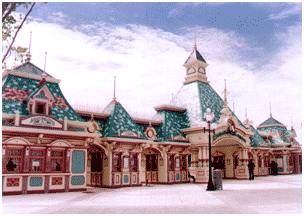
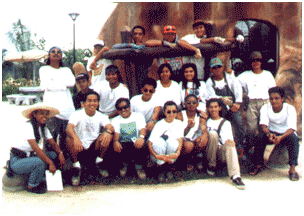
A place of dream, magic, adventure and art. I had the privilege to be a member of the group of scenic artists at the Philippine's first world class theme park, Enchanted Kingdom in Santa Rosa, Laguna. Our team of twenty-nine selected visual artists worked under the tutelage of Bob Dennis, Art Director of Landmark Entertainment Group, a world leader in theme park design and development based in the United States of America. Enchanted Kingdom features seven intricately themed zones and offers more than twenty-one thrilling rides and attractions for the entire family on a spacious area of seventeen hectares.
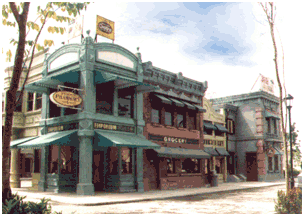
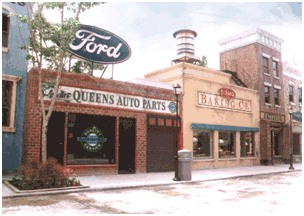

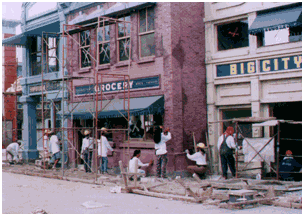
Edifices transformed in time. Paint dabbing, scumbling and sponging are
some of the applied creative techniques in doing faux finishes and tromp
l'eoil art. The photographs above illustrate the procedures on
how to achieve the nostalgic ageing look on the facade of an edifice
depicting the 1930's Brooklyn, New York City. Brooklyn Place is one of the
park zones at Enchanted Kingdom.
Our work included months of rigid training on the fundamentals of scenic art
with emphasis on shop safety procedures.

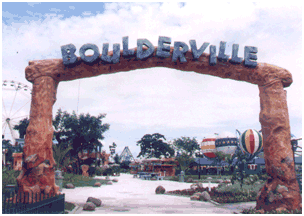
Boulderville is the pre-historic cartoon village at Enchanted Kingdom. The images on the left are some of my decorative cave paintings adorning the pillars of the zone entrance. Every cave wall at Boulderville was illustrated either with animals or animated human cave dwellers.
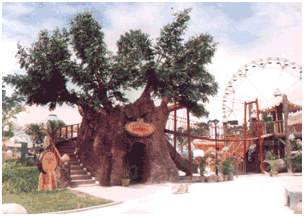
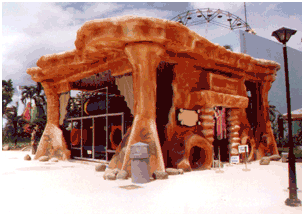

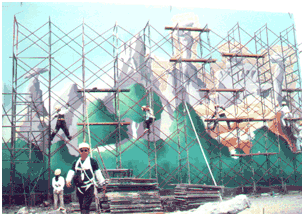
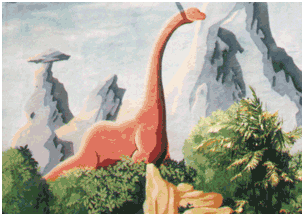

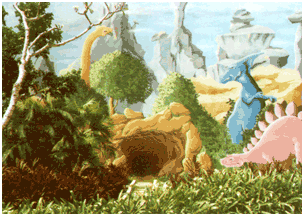
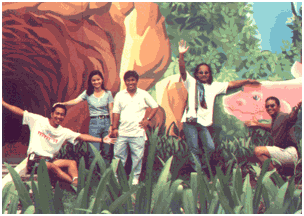
With my creative colleagues posing at a detail of the finished giant artwork
and notice the enormous size comparison.
The mural at Boulderville was creatively designed to blend with the theme
park's foliage. Dinosaurs combined with pre-historic elements suggest an
interesting backdrop for photo opportunities. I was one of the principal
illustrators for this project with some grisaille work done directly on
concrete before rendering several layers of high performance polyurethane
paint.

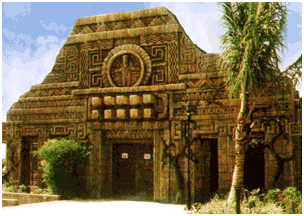
Jungle Outpost is the park zone that features the Amazon's rich environment and culture of Southern America. The place sets the mood for an exotic adventure and the quest for rare archeological artifacts.

